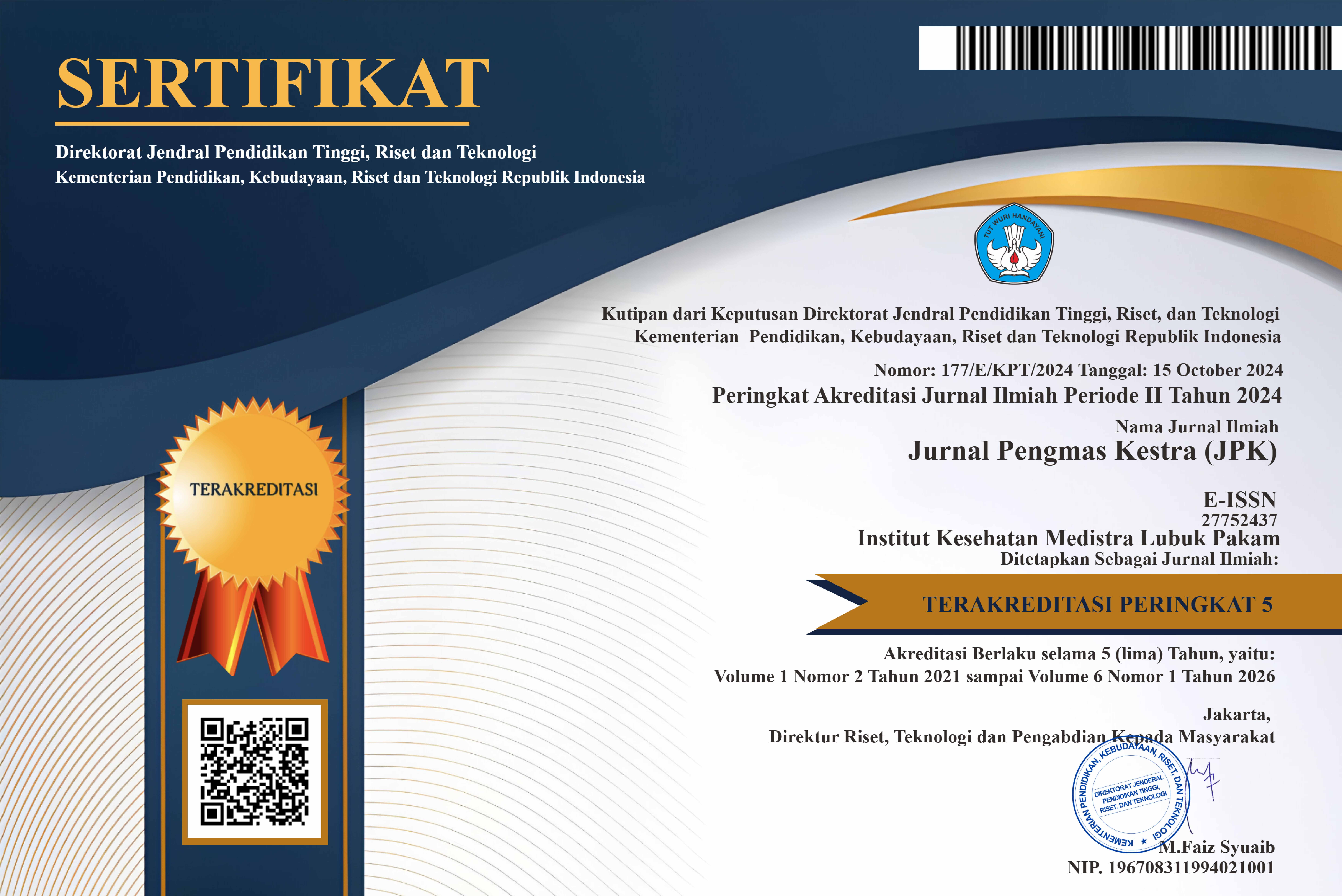Improving Cervical Cancer Awareness Among Reproductive-Age Couples:An Educational Approach Using Visual Inspection with Acetic Acid (IVA)
DOI:
https://doi.org/10.35451/jevx5211Keywords:
IVA, Reproductive-Age Couple, Health Education, Cervical Cancer, Early DetectionAbstract
Cervical cancer is one of the leading causes of death among women in developing countries, primarily due to delays in early detection. According to data from the World Health Organization, there are more than 342,000 cervical cancer-related deaths each year, with 90% of these cases occurring in low- and middle-income countries. In Indonesia, cervical cancer ranks as the second most common cancer after breast cancer, with over 36,000 new cases annually and a death toll reaching 18,000. Visual Inspection with Acetic Acid (IVA) is a simple and affordable screening method that can be performed at primary healthcare facilities. This community service activity aims to increase the knowledge, attitudes, and readiness of couples of reproductive age (CoRA) in conducting early detection of cervical cancer through family-based education. The activity was carried out using lectures supported by media such as leaflets and videos. A total of 30 CoRA participants from the Sukorame health center area took part in the program. The education was delivered through lectures, interactive discussions, and educational video screenings. The education on VIA screening for couples of reproductive age proved effective in improving their understanding, attitudes, and readiness to carry out early detection of cervical cancer. Prior to the education, most participants lacked awareness about the importance of VIA screening. However, after the session, there was a significant increase in knowledge (86.67%), willingness to undergo screening (66.67%), and shared awareness between partners (60%) about the importance of early detection.This interactive and contextual educational approach was effective in building awareness and encouraging preventive action at both family and community levels.
References
[1] Globocan,“Global Cancer Observatory: Cancer Today,” Lyon: IARC.2021
[2] World Health Organization,”Cervical Cancer Elimination Initiative: 2021–2030 Strategy”, Geneva: WHO,2021.
[3] Kementerian Kesehatan RI,”Pedoman Nasional Skrining Kanker Serviks dengan Metode IVA”,2022.
[4] D. Safitri et al,“Persepsi Pasangan Usia Subur terhadap Pemeriksaan IVA di Daerah Rural”,Jurnal Kesehatan Reproduksi, vol. 10, no. 1, pp. 45–54,2023.
[5] R. Sitti et al,“Edukasi Pencegahan Kanker Serviks Pada Wanita Usia Subur Dengan Peningkatan Pengetahuan Tentang Tes Inspeksi Visual Asam Asetat (IVA)”,Media Implementasi Riset Kesehatan, vol. 6, no. 1,2025.
[6] M. Lestari and N. Wahyuni,“Keterlibatan Suami dalam Deteksi Dini Kanker Serviks,”Jurnal Keluarga Sehat, vol. 7, no. 2, pp. 80–89,2021.
[7] A. Wicaksana,“Panduan Program Nasional Gerakan Pencegahan dan Deteksi Dini Kanker Leher Rahim dan Kanker Payudara”,2025.
[8] H. Salehiniya et al,“Factors related to cervical cancer screening among Asian women”,Eur. Rev. Med. Pharmacol. Sci., vol. 25, pp. 6109–6122,2021.
[9] A. R. Putri,et al,“Efektivitas Edukasi Audiovisual dalam Meningkatkan Pengetahuan IVA”,Jurnal Promkes, vol. 9, no. 1, pp. 23–30,2021.
[10] S. Notoatmodjo,”Promosi Kesehatan dan Perilaku Kesehatan”, Jakarta: Rineka Cipta,2020.
[11] R. N. Astuti, A. R. Pratiwi, and S. Widyaningsih,“The Role of Spouse Involvement in Reproductive Health Education”,Journal of Community Health Nursing, vol. 40, no. 1, pp. 45–52,2023.
[12] R. Yulianti and H. Fitriana,“Pengaruh Edukasi terhadap Sikap Wanita Usia Subur tentang Pemeriksaan IVA”,Jurnal Keperawatan dan Kesehatan Masyarakat, vol. 11, no. 1, pp. 23–30,2022.
[13] A. Y. Siregar, R. Nasution, and N. L. Lubis,“Efektivitas Penyuluhan Kesehatan Terhadap Kesediaan Ibu Melakukan Deteksi Dini Kanker Serviks di Puskesmas”,Jurnal Kesehatan Masyarakat Andalas, vol. 15, no. 2, pp. 88–94,2021.
[14] R. Indrawati, S. Wulandari, and H. Santosa,“Peran Suami dalam Mendukung Pemeriksaan IVA pada Istri”,Jurnal Promosi Kesehatan Indonesia, vol. 17, no. 3, pp. 189–197,2022.
[15] N. D. Lestari, D. K. Sari, and Y. Kurniawan,“Barriers to Cervical Cancer Screening in Developing Countries”,Asian Pacific Journal of Cancer Prevention, vol. 22, no. 2, pp. 341–349,2021.
[16] A. Rahmawati, A. Zulaikha, and L. Dewanti,“Family support as a determinant factor in early detection of cervical cancer”,Asian Journal of Public Health, vol. 8, no. 1, pp. 25–32,2023.
[17] L. Handayani, A. M. Putri, and S. Wahyuni,“Peran komunikasi interpersonal dalam peningkatan pemahaman tentang IVA”,Jurnal Komunikasi Kesehatan, vol. 12, no. 1, pp. 48–55,2021.
[18] S. R. Dewi, D. A. Pratiwi, and A. Widodo,“Community-based cervical cancer screening through culturally sensitive health education”,Jurnal Kesehatan Masyarakat, vol. 17, no. 3, pp. 215–223,2021.
[19] N. Oktaviani, D. Fitria, and R. Yunita,“Strategi edukasi inklusif dalam peningkatan cakupan skrining kanker serviks,”Jurnal Promkes, vol. 10, no. 2, pp. 165–174,2022.
[20] L. W. Green and M. W. Kreuter,”Health Program Planning: An Educational and Ecological Approach, 4th ed”, New York: McGraw-Hill,2005.
[21] K. Glanz, B. K. Rimer, and K,”Viswanath, Health Behavior: Theory, Research, and Practice, 5th ed”, San Francisco: Jossey-Bass,2015.
Downloads
Published
Issue
Section
License
Copyright (c) 2025 Nathasia Haryono, Wilda Wahyuni Siregar, Raisha Octavariny, Kurniawati Kurniawati, Khomaina Aula

This work is licensed under a Creative Commons Attribution 4.0 International License.
Copyright in each article is the property of the Author.




















